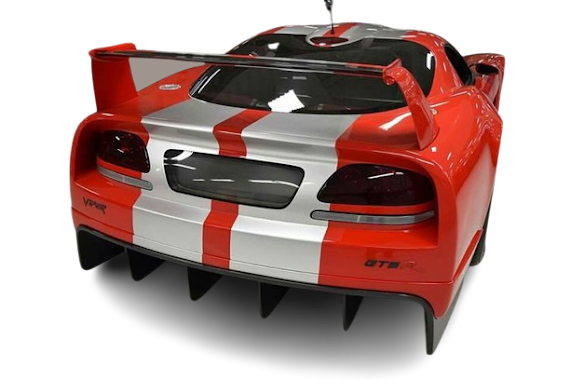Dodge Viper GTS-R (2000)
The Dodge Viper GTS-R Concept, unveiled at the 2000 North American International Auto Show in Detroit, was a raw and radical reinterpretation of the American supercar. Designed as a track-focused evolution of the production Viper, the GTS-R Concept pushed the boundaries of aggressive styling and motorsport intent. Though it never entered production in this exact form, the concept heavily influenced the third-generation Viper (launched in 2002) and remains one of the most visually striking concept cars ever produced by Dodge.
History
By the late 1990s, the Dodge Viper had already cemented its reputation as a brutal, analog performance machine. The first-generation RT/10 and GTS models had become symbols of raw American horsepower. Meanwhile, the Viper GTS-R race cars were racking up victories in international endurance racing, including class wins at the 24 Hours of Le Mans and Daytona.
The GTS-R Concept was introduced as a celebration of that motorsport dominance — a vision of what a next-generation Viper could look like if built from the ground up with track performance as the central design driver. Dodge and Chrysler’s Performance Vehicle Operations (PVO) division wanted to blend the DNA of the racing Viper with a future-ready design for the road.
While not a direct preview of a production car, the concept became a design and engineering foundation for the 2003 Viper SRT-10, marking a pivotal moment in the Viper’s evolution from brutal roadster to more refined supercar.
Design Features
The GTS-R Concept took the Viper’s iconic silhouette and made it lower, wider, and far more extreme. Its stance was unapologetically aggressive, with massive air intakes, a forward-thrusting nose, and a rear diffuser straight from the race track. The long hood and short deck proportions remained, but the bodywork was extensively sculpted for both performance and drama.
The front fascia featured a deep splitter, side-exit exhausts returned, and the fenders flared out dramatically to house ultra-wide wheels. A prominent rear wing and vented rear bumper finished the race-inspired aesthetic. Functional elements such as a vented carbon-fiber hood, center-lock wheels, and aerodynamic side skirts emphasized that this was not just a design study — it was built with performance at its core.
The concept wore a white base color with racing stripes and red detailing, referencing the livery of the factory Viper GTS-R race cars. The visual identity was all about speed, aggression, and dominance.
Specs
While not a running prototype at launch, the GTS-R Concept was based on a serious engineering framework. Dodge envisioned it with a heavily upgraded version of the Viper’s signature V10 engine, incorporating race-derived technology and weight-saving materials.
Projected specs included:
-
8.3-liter V10 engine (enlarged from 8.0 L)
-
Estimated output of 500 horsepower and 525 lb-ft of torque
-
6-speed manual transmission
-
Lightweight chassis with advanced suspension geometry
-
Carbon-fiber and aluminum bodywork for reduced weight
Targeted performance (estimates):
-
0–60 mph in under 4.0 seconds
-
Top speed over 190 mph
-
Track-tuned suspension and braking systems
Though these numbers were conceptual, they laid the groundwork for the future Viper SRT-10, which would later launch with 500 hp and a similar chassis philosophy.
Production Status
The 2000 Dodge Viper GTS-R Concept did not enter production, but it served as a crucial transition point. Its design language and engineering goals directly influenced the 2003–2010 Dodge Viper SRT-10, which adopted many of the concept’s lines, dimensions, and mechanical enhancements.
Moreover, the GTS-R Concept helped reframe the Viper brand from wild muscle machine to serious supercar contender, capable of competing with global names like Ferrari and Corvette Z06 on both street and track.
The concept itself remains a one-off, preserved by Stellantis (formerly FCA) and occasionally displayed at car shows and historic events. Its legacy lives on not only in the third-gen Viper, but also in the visual and technical DNA of later SRT models.



Comments
Post a Comment